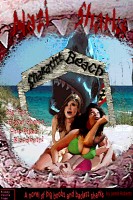Introduction
December 1st, 2008, several friends challenged me to give positive, subtextual analyses of five awful films. Braving the torture of the most brain-sucking, insipid barbarisms ever committed to celluloid, I now bring you the second of my critiques.
Film: The Beast of Yucca Flats (1965)
Subtextual analysis: Queer theory
In The Beast of Yucca Flats, filmmaker Coleman Francis brings his audience a startling depiction of heteronormativity defending its hegemony against deviations from its sexual standard.
The film begins with a pre-credit sequence of a beautiful, slightly androgynous woman coming out of the shower. She is then killed by an unseen man. This sequence sets the stage for the films thematic concern with repressed homosexuality bubbling up into violence.
After the credits, we are shown a Russian scientist, who has lost his family, bringing scientific secrets to America. He is chased by Russian spies into Yucca flats, where A-Bomb testing is being done. The explosion transforms him into a monster that desires only to kill. Or so it seems.
The scientist has just lost his family. This alienation from a normal family is not the cause of, but is caused by, his becoming a monster, thematically speaking. For in this film, the constant, clipped narration insists on equating science and 'progress'--the 'whirlwind of progress.' Characters are referred to as 'caught' in progress. Science is not itself in this film; it is a symbolic stand-in for liberality in society; that is, the beginning of alternative lifestyles.
The scientist is transformed into a monster by 'science'; he has come out of the closet, and for society, this is a transgressive figure, because uncategorizable, neither male nor female. He is a monster. Hence, he is chased into Yucca Flats bringing secrets to America. The secret of his homosexuality. His becoming a monster is his coming out of the closet.
The first killing the monster performs, then, is naturally upon a heteronormal couple. A young man and a young woman stop along the side of the road with car troubles. The monster kills first the man then the young woman. This is a semiotic enactment of the fears of heterosexual society that homosexuals are destructive of family.
The heroes of the film are then revealed, Jim and Joe. Joe is the first to discover the bodies. He then drives to Jim's house and calls him down. Though Jim--Jim Archer, to emphasize the phallic masculinity of his character, the one who aims a phallus and shoots--is found in bed with a beautiful woman, he instantly leaves the bed upon Joe's call.
We are even told that Jim and Joe patrol the desert together seven days a week. Jim and Joe are, as is emphasized by their similar-sounding names, repressed homosexuals. They love one another, but cannot reveal it. They are the perfect team to do battle with the monster--the monster they cannot face in themselves. It is the monster because, in Julia Kristeva's terms, it is Abject--it is what they themselves potentially could, and perhaps will, become.
At the same time, we are introduced to a family of city-folk passing through. The children feed soda to pigs and notice coyotes around the road. The narration states that the coyotes are being driven from their grounds by missile testing. Again, this is emphasizing how science--social progress--is destructive of the order of nature; for pigs normally don't drink soda, and coyotes normally avoid human settlements. Hence the arguments of conservatives that homosexuality is against nature.
This family stops along the road and the children become lost. The father goes looking for them, worried. The worry is the exposure of children to the monster of homosexuality.
At the same time, Jim Archer has decided to enter a plane to hunt for the monster by rifle. He spots the father, assuming the father is the monster, begins shooting. This is only too appropriate. Jim is unconsciously trying to destroy the very family form he has deceived himself into trying to belong to; he is unconsciously aiding the monster.
Meanwhile the monster watches the children bending over a pool to drink. As he does, he holds his large stick horizontally, pointing his phallus at the vulnerable boys. When the boys detect him, they run screaming, while the monster waves his stick.
The boys hide in a cave--taking shelter in the womb, in a vaginal opening. The monster cannot find them there, though it comes right to the opening itself. It cannot plumb the depths of femininity. It merely tosses down its stick in representation of sexual frustration.
As the boys make an escape, Joe and Jim have a showdown with the monster. They shoot it--with their phallic guns--and the monster begins to wrestle with them. Joe and Jim wrestle with their latent homosexual desires, and eventually heteronormativity triumphs, as they destroy the monster--though Joe, the most effeminate, is almost overcome.
The final shot is of a rabbit wandering before the face of the dead monster--Coleman Francis emphasizing the triumph of the natural over the unnatural.
All throughout this film a mysterious voice-over renders the proceedings abstract. Though we know it is Jim shooting the father from a plane, the narrator states, "A man runs; somebody shoots at him." The universality of the events are thus brought forward by Francis, who is trying to incite the fear of the family-destroying homosexuality alternative lifestyles, "progress," is ushering in.
There is no missing the strong attack of this film. For a greater understanding of the way heteronormative discourse is used to discourage and diminish the esteem of alternative sexualities, The Beast of Yucca Flats is highly recommended to gay/bi/lesbian groups.
What a load of hooey.
Help make this site more interesting through discussion:
Subtextual Criticism Challenge: The Beast of Yucca Flats
Author: Jared Roberts
Subscribe to:
Post Comments (Atom)

0 comments:
Post a Comment